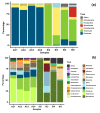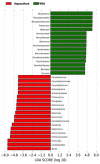Red Cusk-Eel (Genypterus chilensis) Gut Microbiota Description of Wild and Aquaculture Specimens
- PMID: 35056554
- PMCID: PMC8779451
- DOI: 10.3390/microorganisms10010105
Red Cusk-Eel (Genypterus chilensis) Gut Microbiota Description of Wild and Aquaculture Specimens
Abstract
Chile has promoted the diversification of aquaculture and red cusk-eel (Genypterus chilensis) is one of the prioritized species. However, many aspects of the biology of the species are unknown or have little information available. These include intestinal microbiota, an element that may play an important role in the nutrition and defense of cultured animals for meat production. This study compares the microbiota composition of the intestinal contents of wild and aquaculture fish to explore the microbial communities present and their potential contribution to the host. DNA was extracted from the intestinal content samples and the V4 region of the 16S rRNA gene was amplified and sequenced using the Ion Torrent platform. After the examination of the sequences, strong differences were found in the composition at the level of phylum, being Firmicutes and Tenericutes the most abundant in aquaculture and wild condition, respectively. At the genus level, the Vagococcus (54%) and Mycoplasma (97%) were the most prevalent in the microbial community of aquaculture and wild condition, respectively. The evaluation of predicted metabolic pathways in these metagenomes showed that in wild condition there is an important presence of lipid metabolism belonging to the unsaturated fatty acid synthesis. In the aquaculture condition, the metabolism of terpenoids and polyketides were relevant. To our knowledge, this is the first study to characterize and compare the intestinal microbiota of red cusk-eel (Genypterus chilensis) of wild and aquaculture origin using high-throughput sequencing.
Keywords: Genypterus chilensis; Ophidiidae; Tenericutes; aquaculture; fish; microbiome; microbiota; next-generation sequencing.
Conflict of interest statement
The authors declare no conflict of interest.
Figures






References
-
- Servicio Nacional de Pesca y Acuicultura (SERNAPESCA) Anuarios Estadísticos de Pesca y Acuicultura. [(accessed on 15 November 2021)];2021 Available online: http://www.sernapesca.cl/informacion-utilidad/anuarios-estadisticos-de-p....
-
- Servicio Nacional de Pesca y Acuicultura (SERNAPESCA) Programa de Gestión Sanitaria para la Acuicultura. [(accessed on 15 November 2021)];2021 Available online: http://pgsa.sernapesca.cl/antecedentes/
-
- Córdova-Alarcón V.R., Araneda C., Jilberto F., Magnolfi P., Toledo M.I., Lam N. Genetic Diversity and Population Structure of Genypterus chilensis, a Commercial Benthic Marine Species of the South Pacific. Front. Mar. Sci. 2019;6:748. doi: 10.3389/fmars.2019.00748. - DOI
-
- Tascheri R., Sateler J., Merino J., Ojeda V., Montecinos M. Estudio biológico-pesquero congrio colorado, congrio negro, congrio dorado en la zona centro-sur. IFOP; Valparaíso, Chile: 2003. pp. 1–356.
-
- Chong J., González P. Ciclo reproductivo y talla media de madurez del congrio colorado, Genypterus chilensis (Guichenot, 1881) en el litoral de Talcahuano, Chile. Rev. De Biol. Mar. Oceanogr. 2009;44:257–262. doi: 10.4067/S0718-19572009000100027. - DOI
Grants and funding
LinkOut - more resources
Full Text Sources

